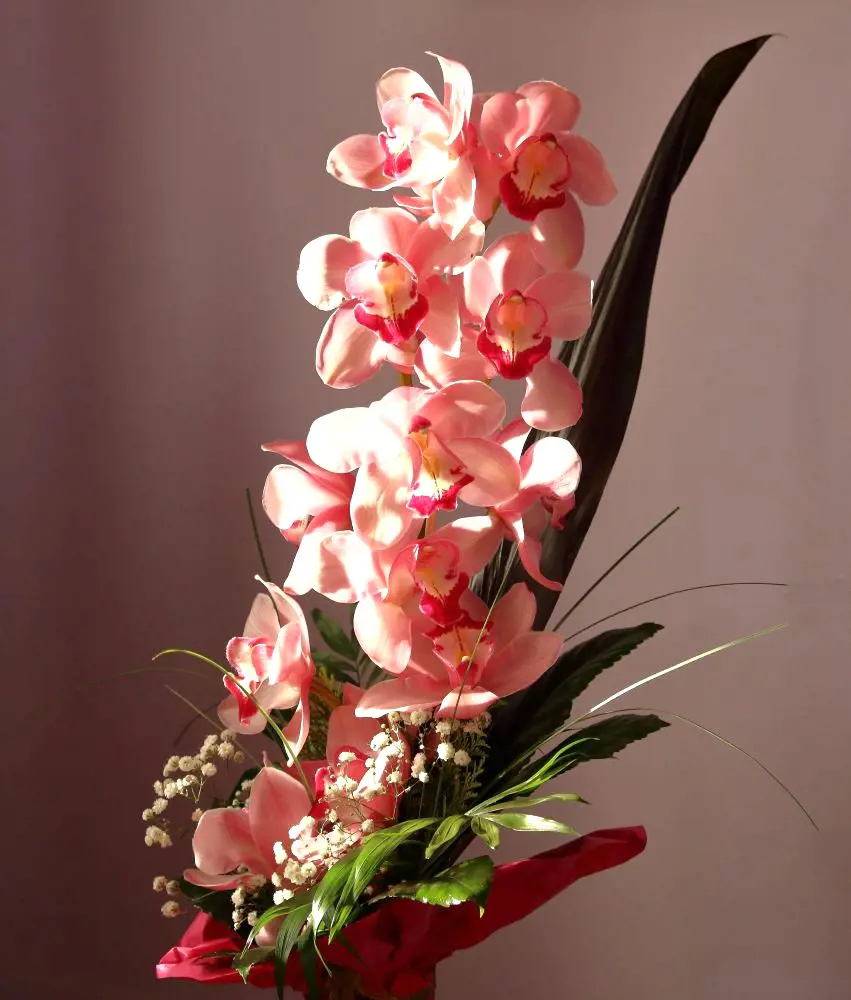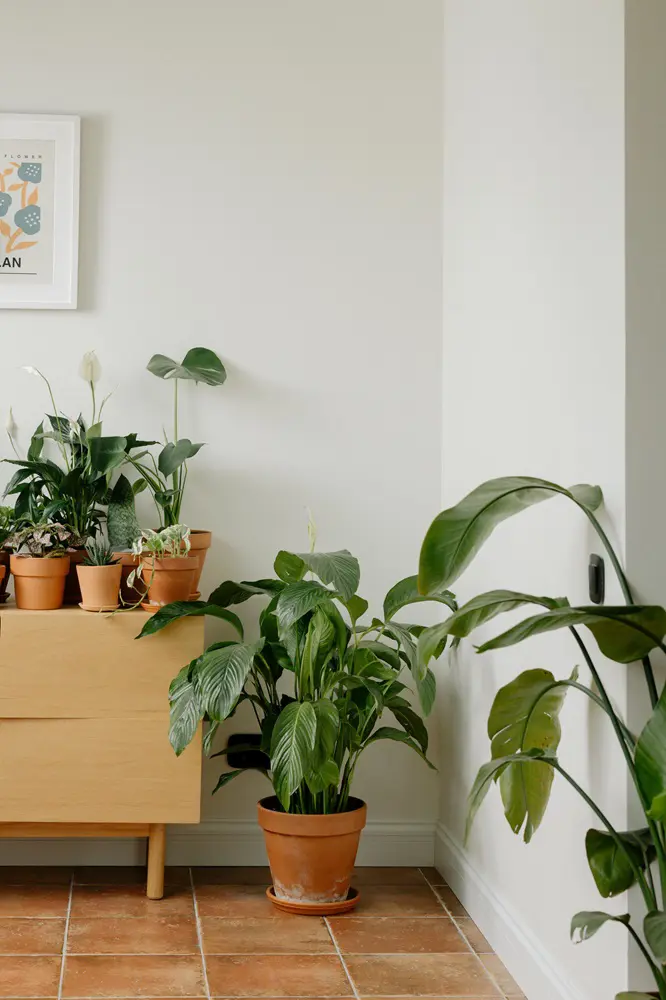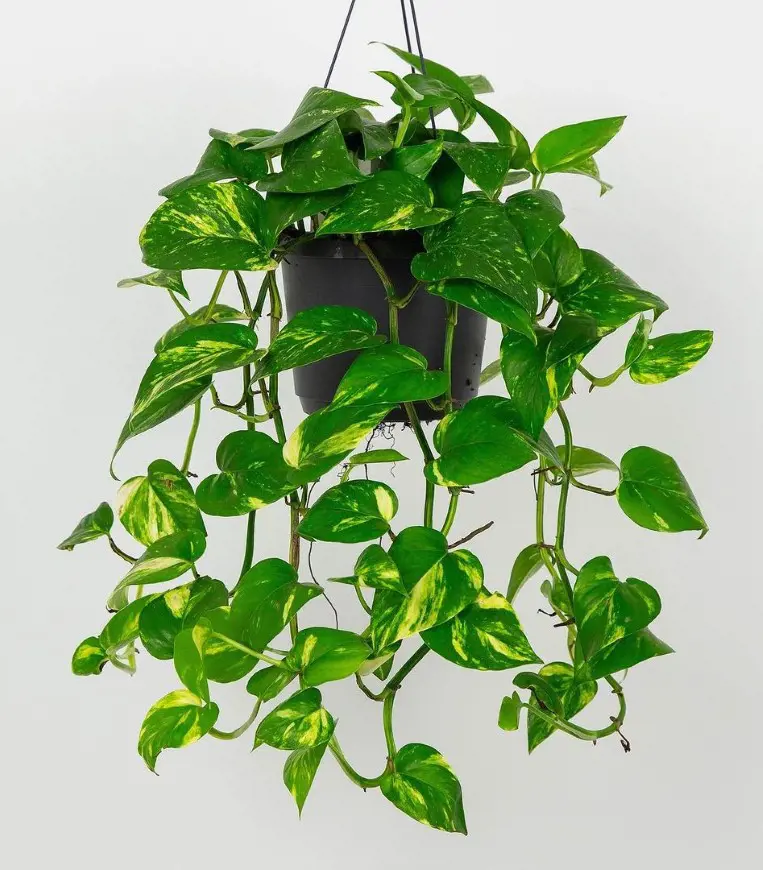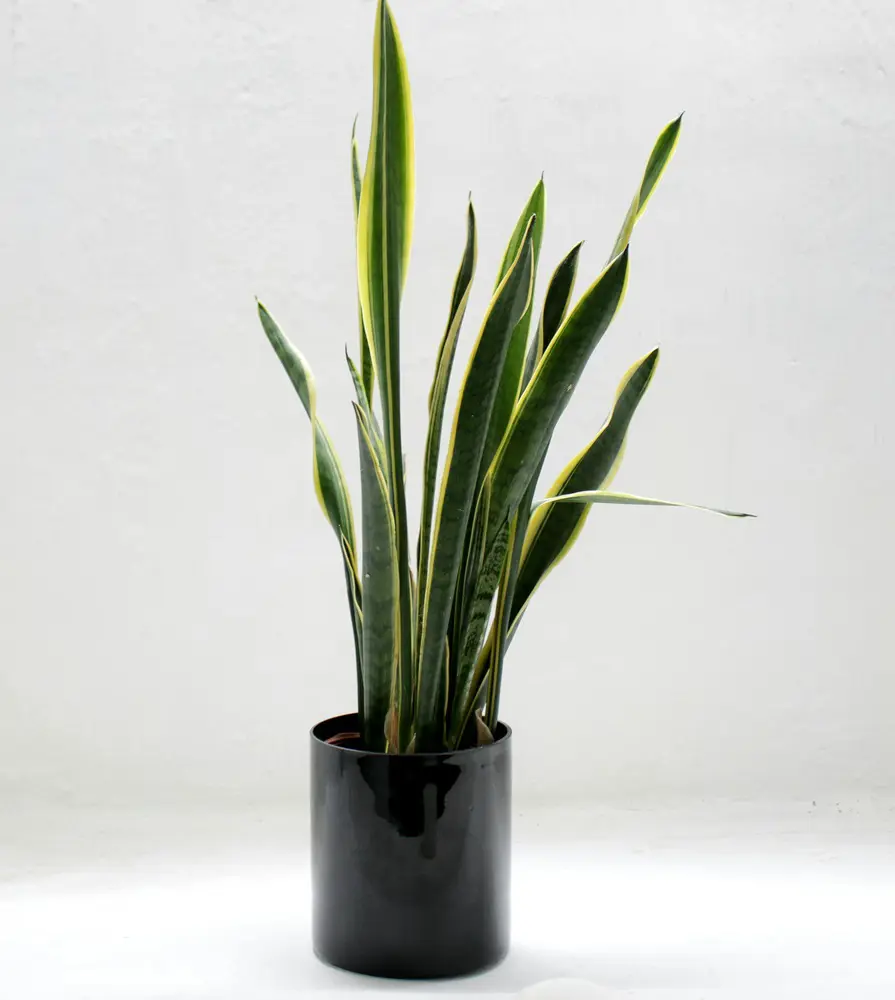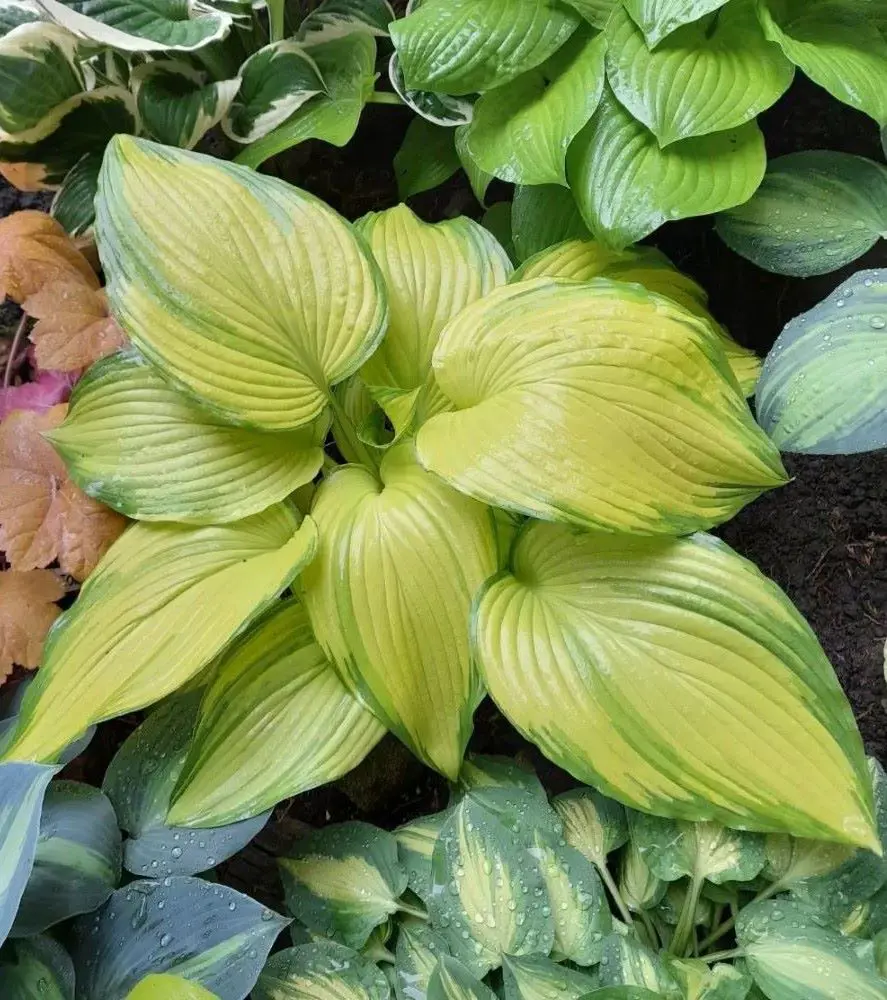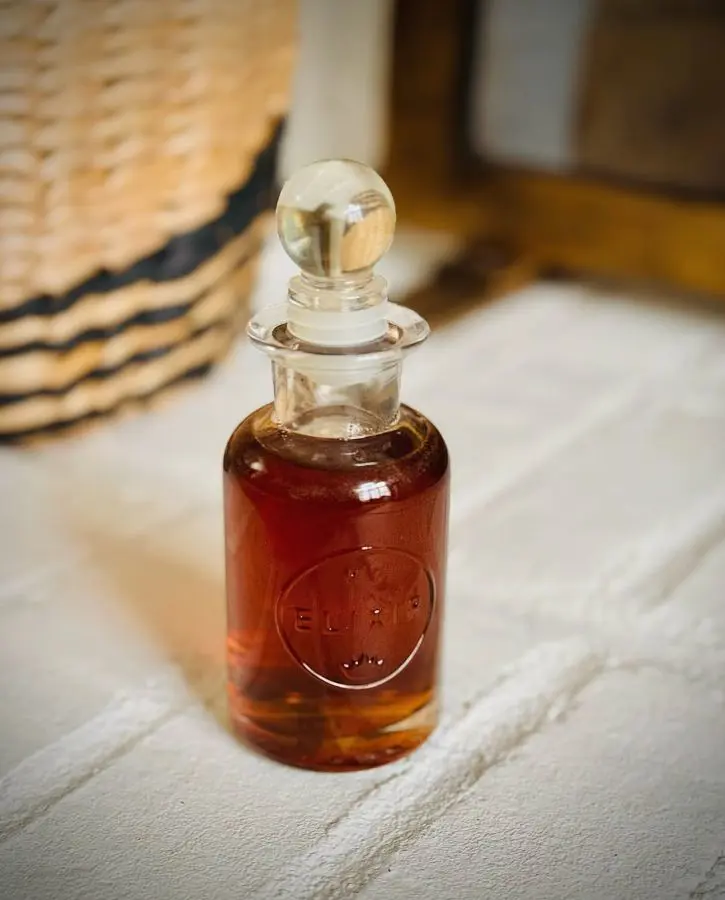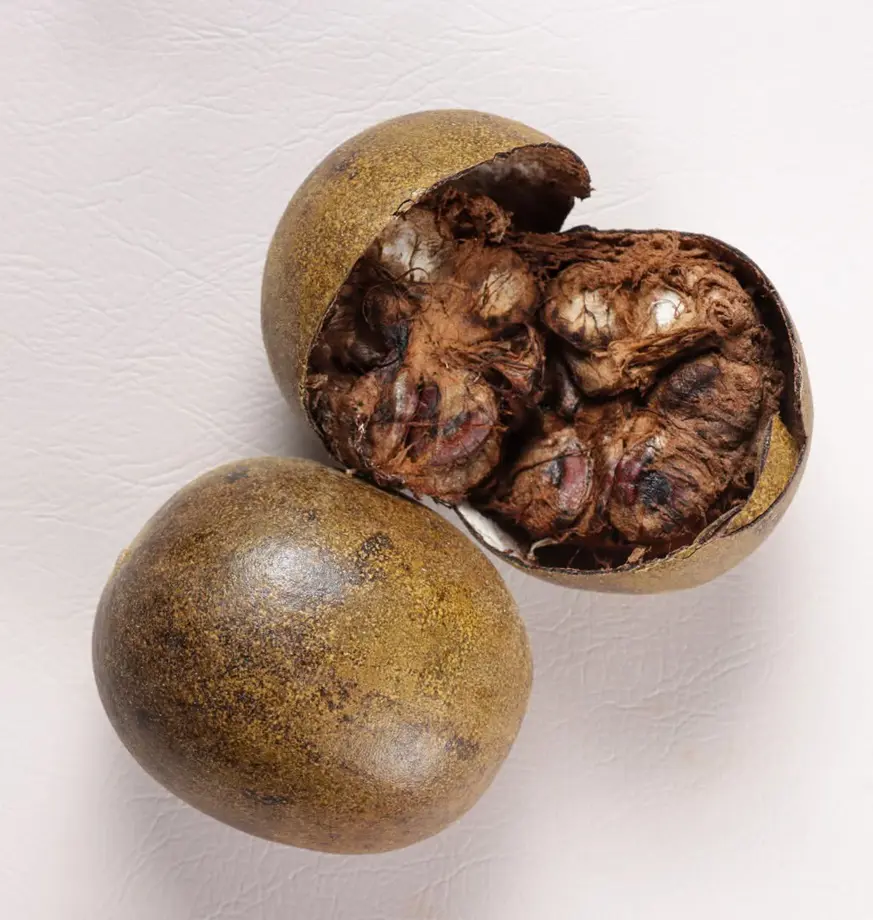Clematis Care: Tips To Prune And Grow Plant
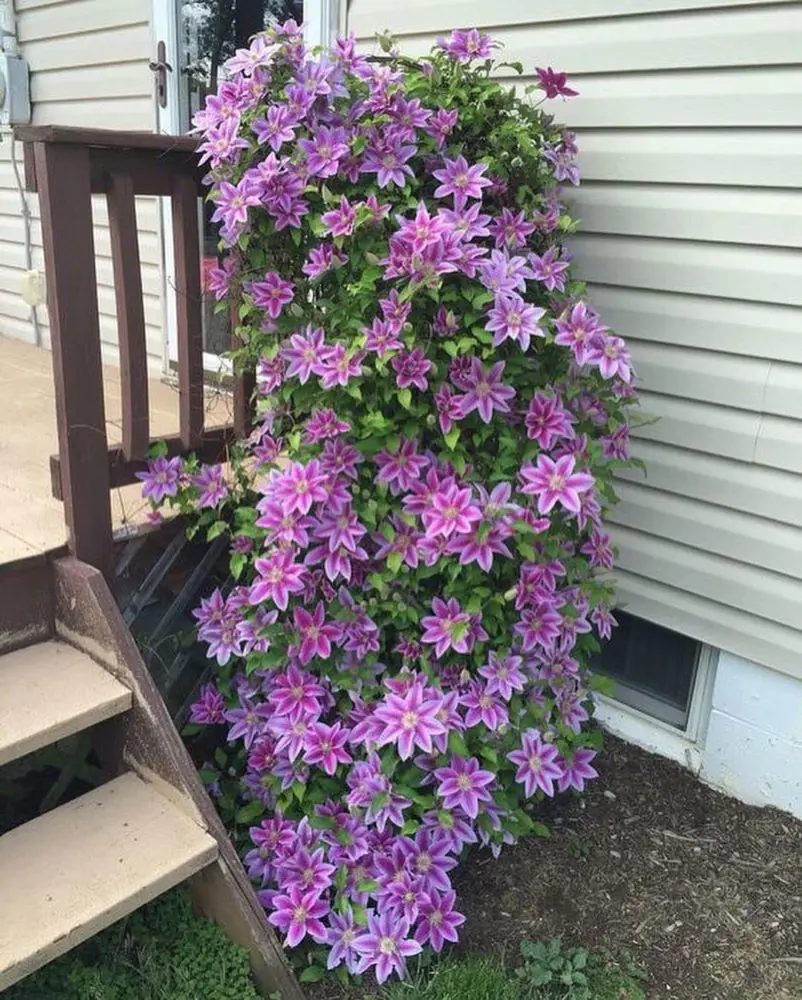
This post may contain affiliate links. If you make a purchase through links on our site, we may earn a commission.
Clematis can be a bit picky when it comes to caring for them as they require regular pruning, potting and repotting, and right watering and fertilization. Gardeners grow clematis for its showy, colorful flowers that come in a variety of shapes and sizes.
This versatile plant can be trained to climb trellises, arbors, or fences, making it an excellent choice for adding vertical dimension to landscapes. While clematis can be relatively easy to grow, there are a few things that we will discuss in detail below that you should keep in mind.
Clematis Plant Overview
| Scientific Name | Clematis spp. |
| Common Name | Clematis, Leather flower |
| Family | Ranunculaceae |
| Type | Perennial, shrub, vine |
| Size | 8-20 ft. long (large flower varieties), 3 to 5 feet long (small flower varieties) |
| Sunlight Requirement | Full |
| Soil Type/pH | Loamy, well-drained/Neutral |
| Hardiness Zone | 4-9 (USDA) |
| Native Area | North America |
| Toxicity | Toxic to pets, toxic to people |
What Is A Clematis?
Clematis is a genus of flowering vines and shrubs renowned for their spectacular blooms. These plants typically feature woody stems that can climb or trail, with tendrils or leaf stalks that help them attach to supports.
Clematis flowers are diverse, ranging in color from white and pale pastels to vibrant purples, pinks, and blues. They come in a variety of shapes, including single, semi-double, and double blooms, and some varieties have eye-catching contrasting centers.
In addition to its aesthetic appeal, clematis serves practical purposes in the garden, such as providing shade, privacy screening, and attracting pollinators like bees and butterflies. The flowers typically bloom during the spring and summer months, although the exact blooming period can vary depending on the specific variety and growing conditions.
How To Grow Clematis
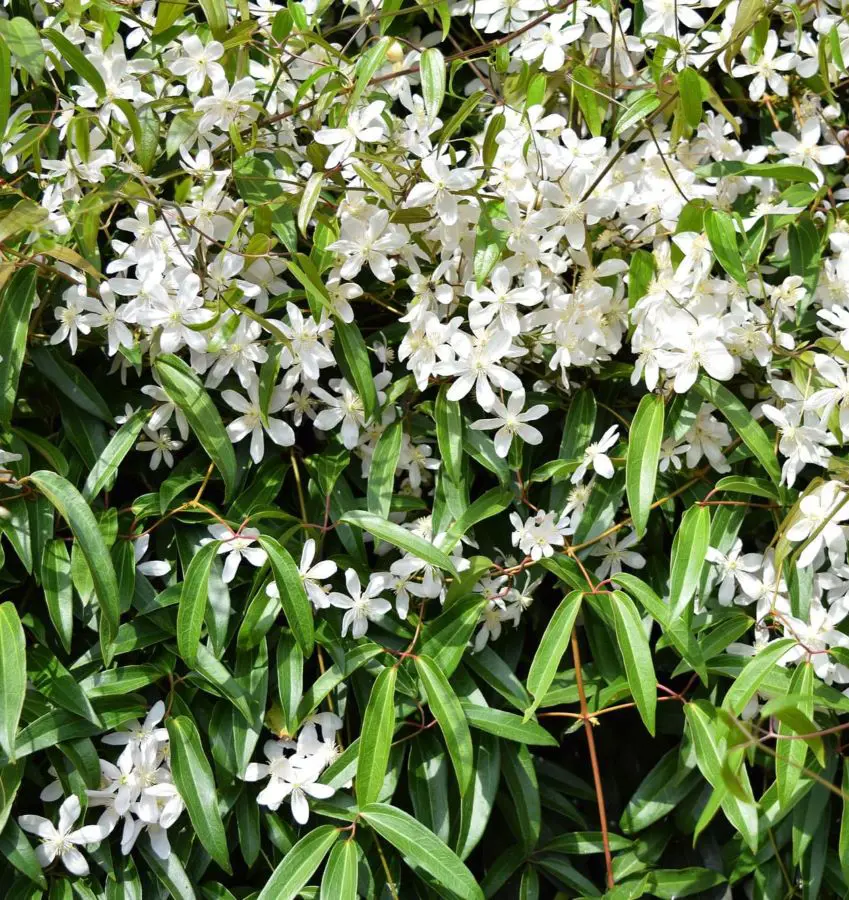
The clematis plant is primarily grown outdoors in gardens, where it grows in well-drained soil and ample sunlight. It can also be grown in containers on patios, balconies, or other outdoor areas, provided they have a sturdy support structure for climbing.
When To Plant
It's best to plant clematis in the spring or fall, but you can also plant them in the summer with care, especially in cooler northern regions. Different types of clematis bloom at different times. For instance, the Clematis gouriana blooms from August to February, while the Ernest Markham Clematis flowers twice a year, once in late spring and again in late summer to fall.
For spring planting, wait until after the last frost date in your area to ensure that the soil has warmed up sufficiently for root growth. This is typically in late March or early May, depending on your location.
Likewise, for fall planting, aim to plant clematis at least 6–8 weeks before the first frost date. This gives the plant time to establish before winter dormancy. The process is typically carried out in late summer or early fall, around August or September.
Where To Plant
While planting a clematis vine, choose a location that receives ample sunlight, ideally with at least six hours of direct sunlight per day. Additionally, it's important to choose a site with well-draining soil that is rich in organic matter.
These purple flower plants thrive when their roots are kept cool and shaded, so consider planting them near other low-growing plants or shrubs that can provide some protection from the sun. Ensure that there is adequate space for the clematis to grow and spread, as some varieties can reach several feet in height and width.
How To Plant
Here is how to plant clematis:
- Pick a good spot with lots of sunlight, ideally getting around six hours of sun every day.
- Dig a hole that's twice as big as the root ball, and put the clematis a bit deeper than it was in the pot.
- Fill the hole with soil, making sure the first leaves are just under the surface.
- After planting your clematis, give it a good watering, and then water it every two weeks for the first three months.
- Make sure to provide a strong trellis or support for the plant to climb on, giving it space to grow and spread.
Growing Clematis From Seed
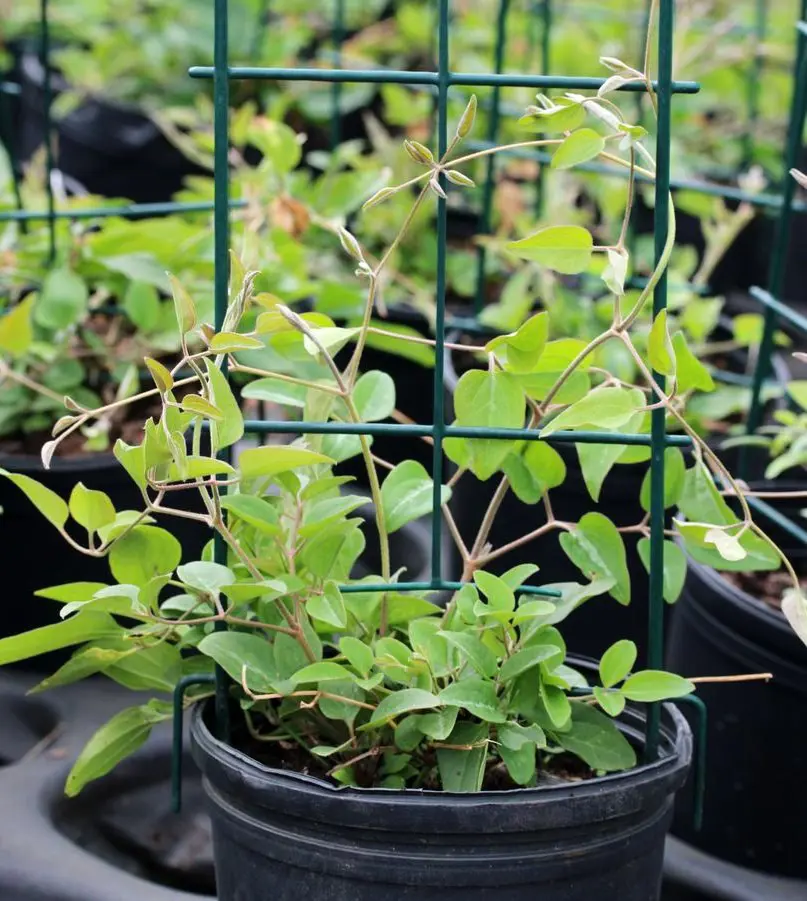
Growing clematis from seed is less common compared to other methods, such as propagation from cuttings or purchasing established plants. While it is possible to grow clematis from seed, it is not typically recommended. The seeds have a low germination rate, and they may take a long time to sprout, sometimes several months to over a year.
Additionally, clematis seeds may not produce plants that are true to the parent plant, meaning they may not exhibit the same characteristics or flower color as the parent.
If you still wish to try growing clematis from seed, the best time to sow the seeds is in the early spring. Start by scarifying the seeds, which means scratching or nicking the seed coat to help with germination. Then,
- Soak the seeds in water for several hours or overnight before planting.
- Prepare a well-draining seed-starting mix in containers or trays.
- Plant the seeds about ¼ inch deep in the soil and lightly cover them with more soil.
- Keep the soil consistently moist but not waterlogged, and place the containers in a warm, bright location, such as near a sunny window or under grow lights.
Germination may take several weeks to months, so be patient. Once the seedlings have developed several sets of true leaves, they can be transplanted into individual pots or the garden once the weather warms up.
Pruning

Pruning clematis is essential for managing growth, promoting flowering, and maintaining a tidy appearance. The main goal of pruning clematis plants is to stimulate new growth, resulting in bushier, healthier plants with more blooms. It also removes old, woody stems and encourages the development of new, flowering wood.
Dead or damaged stems, overgrown or tangled growth, and a lack of flowering or sparse blooms are some of the signs that clematis is ready to be pruned.
Tools Required
Tools required for pruning clematis include:
- Pruning shears or secateurs for cutting stems up to 1/2 inch in diameter
- Loppers for cutting thicker stems or woody growth
- Gloves to protect hands from thorns and debris
When And How To Prune
The timing and method of pruning depend on the specific pruning group of the clematis variety, which is determined by its blooming habit. Generally, clematis can be divided into three pruning groups:
Group 1
They are early-flowering clematis blooms on old wood in early spring. These plants typically reach a height of 12 to 24 inches and spread between 3 and 10 feet. After flowering, they produce attractive, silky seed heads. They are suitable for Zones 4 to 11. Some popular species include C. heracleifolia, C. integrifolia, and C. recta.
- Pruning Method: After flowers fade, remove them along with any dead or damaged stems. Sometimes, you might need to train or thin out the plant in the following years. For a complete refresh, trim back to about 15cm (6in) from the base after flowering.
Group 2
This group features mid-season-flowering clematis that bloom on both old and new wood. They have big, saucer-shaped flowers with colored centers. They come in a lot of different colors and shapes. Examples like 'Nelly Moser' and 'The President Niobe' belong to this category.
- Pruning Method: When flowers are done, cut them back to a large bud below the flower. In spring, you can tidy up by deadheading and removing any dead ends. Sometimes, you might need to do some selective pruning in the spring, cutting out dead or tangled vines.
Group 3
These are late-flowering clematis that bloom on new wood in late summer or fall, from July until the first frosts. Some examples are Clematis tangutica and Clematis jackmanii.
- Pruning Method: Every March, cut back hard to about 12 inches from the ground. This group is the easiest to prune because they bloom on new growth made earlier in the season.
Combining Groups 2 and 3
Combining these groups can be useful for some clematis. This involves keeping a basic structure while cutting other stems down to the base, which can extend the flowering season.
Additional Pruning Tips
- If you're not sure which group your clematis belongs to, you can watch its flowering time.
- If it blooms before early summer (June), it doesn't need pruning.
- If it blooms from late June onward, prune it in late winter (February).
- Regular pruning helps prevent clematis vines from becoming tangled masses with bare bases and flowers high above eye level.
Common Mistakes While Pruning Clematis
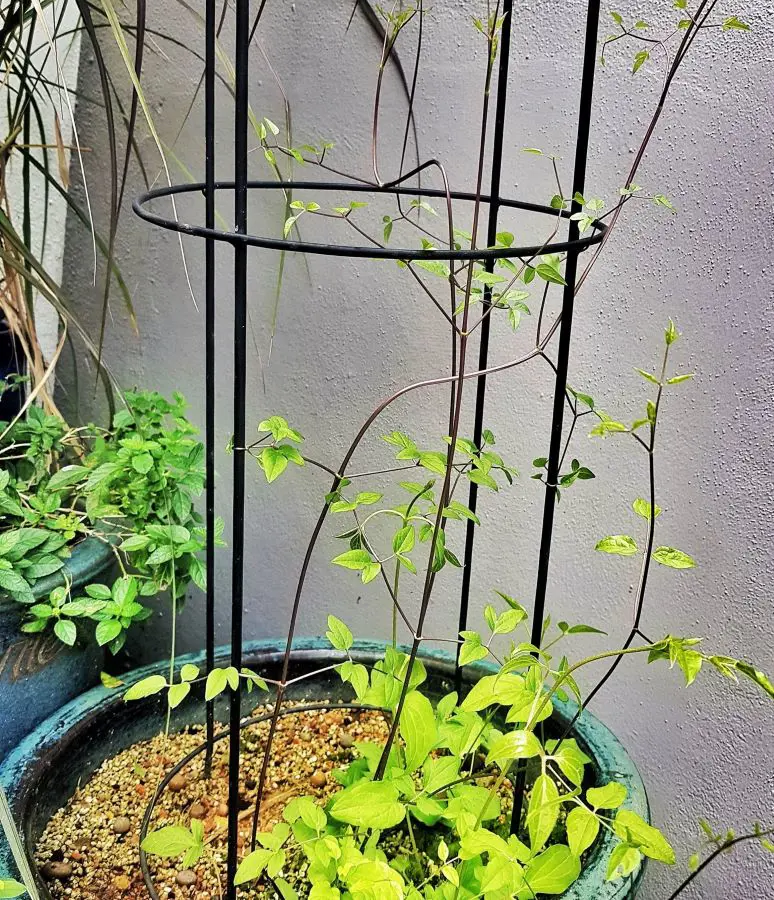
Pruning clematis is super important for keeping them healthy and blooming. But, if you make mistakes, it can mess up how the plant grows and how many flowers it makes. Here are some common mistakes to avoid when pruning clematis:
- Not Pruning at All: If you don't prune your clematis, it can turn into a tangled mess with flowers only at the top. This means you'll have bare stems at the bottom and flowers way up high. Plus, without pruning, your clematis might not make as many flowers, or the flowers it does make might not be as nice.
- Pruning at the Wrong Time: Pruning your clematis at the wrong time can stop it from flowering. It's important to know when your clematis usually flowers so you can prune it at the right time. Different clematis groups need pruning at different times, so timing is key to getting it right.
- Using the Wrong Pruning Techniques: Each clematis group needs different pruning methods to make sure they grow well and flower nicely. Group 1 clematis only need pruning if they get too big, while Groups 2 and 3 need different pruning to make sure they bloom well. Pruning too hard or too lightly can mess up when the plant flowers and how healthy it is.
- Not Knowing Your Clematis Group: If you don't know which group your clematis belongs to, you might prune it wrong and hurt the plant. Each group (Groups 1, 2, and 3) needs different pruning methods, so it's important to know which group your clematis is in to do it right.
Clematis Care

Caring for clematis involves providing them with the right growing conditions and some basic maintenance to ensure healthy growth.. While clematis plants are generally hardy and resilient, they benefit from regular care.
Sunlight
Most clematis varieties prefer full sun to partial shade. Ensure that the plant receives at least six hours of direct sunlight per day for optimal flowering. In hotter climates or during periods of intense sunlight, provide some afternoon shade to protect the plant from heat stress and sunburn.
Water
Clematis prefers consistently moist soil, especially during the growing season. Water deeply and thoroughly, ensuring that the soil around the roots remains evenly moist. Avoid waterlogging, as excessive moisture can lead to root rot.
During hot weather or periods of drought, increase the frequency of watering to keep the soil adequately moist.
Soil
These flowers thrive in well-draining soil that allows excess water to drain away quickly. Heavy or waterlogged soil can lead to root rot and other problems. They also prefer slightly acidic to neutral soil with a pH range between 6.0 and 7.0.
They have shallow roots that benefit from loose, friable soil with good aeration. Avoid compacting the soil around clematis plants, as compacted soil can restrict root growth and water infiltration.
Support
Provide a sturdy support structure for the clematis vine to climb, such as a trellis, arbor, or fence. Ensure that the support is firmly anchored in the ground to withstand the weight of the vine. Train the clematis to climb the support structure by gently guiding the tendrils or stems as they grow.
Mulching
Apply a 2-3 inch layer of organic mulch, such as compost, shredded bark, or straw, around the base of the clematis plant. Mulching helps retain soil moisture, regulate soil temperature, suppress weeds, and improve soil structure. Replenish the mulch as needed to maintain a consistent layer throughout the growing season.
Fertilization
Feed clematis plants with a balanced fertilizer or a fertilizer specifically formulated for flowering vines. Apply fertilizer in early spring as new growth begins and again in midsummer to support blooming.
Follow the manufacturer's recommendations for application rates and frequency, and avoid over-fertilizing, as this can lead to excessive vegetative growth at the expense of flowering.
Temperature
These types of flowers generally prefer moderate temperatures ranging from 60–75°F (15–24°C) during the growing season. During the growing season, provide clematis with a comfortable temperature range to encourage vigorous growth and blooming.
Avoid exposing the plants to extreme heat or cold for prolonged periods, as this can stress the plant and affect its overall health and flowering performance.
Humidity
Clematis plants generally prefer moderate to high humidity levels, especially during the growing season when active growth and flowering occur. Adequate humidity helps keep the plant's foliage lush and healthy while also promoting blooming.
In regions with dry climates, consider increasing humidity levels around clematis plants through regular watering, mulching, and strategic placement near other moisture-loving plants.
Winter Care
In regions with cold winters, clematis may benefit from some winter protection to survive freezing temperatures. Apply a thick layer of mulch around the base of the plant in late fall to insulate the roots and protect them from frost.
Additionally, consider wrapping the base of the plant with burlap or a protective cover to shield it from harsh winter winds and temperature fluctuations. Prune clematis lightly in late winter or early spring to remove any dead or damaged wood and encourage new growth.
Potting and Repotting
When growing clematis in pots, it's important to choose a container that is large enough to accommodate the plant's root system and provides adequate drainage. Use a well-draining potting mix rich in organic matter to promote healthy growth.
As the clematis grows, it may eventually outgrow its container, leading to reduced growth and flowering. When this happens, it's time to repot the plant into a larger container. Repotting is typically done in early spring before new growth begins.
Propagating Clematis
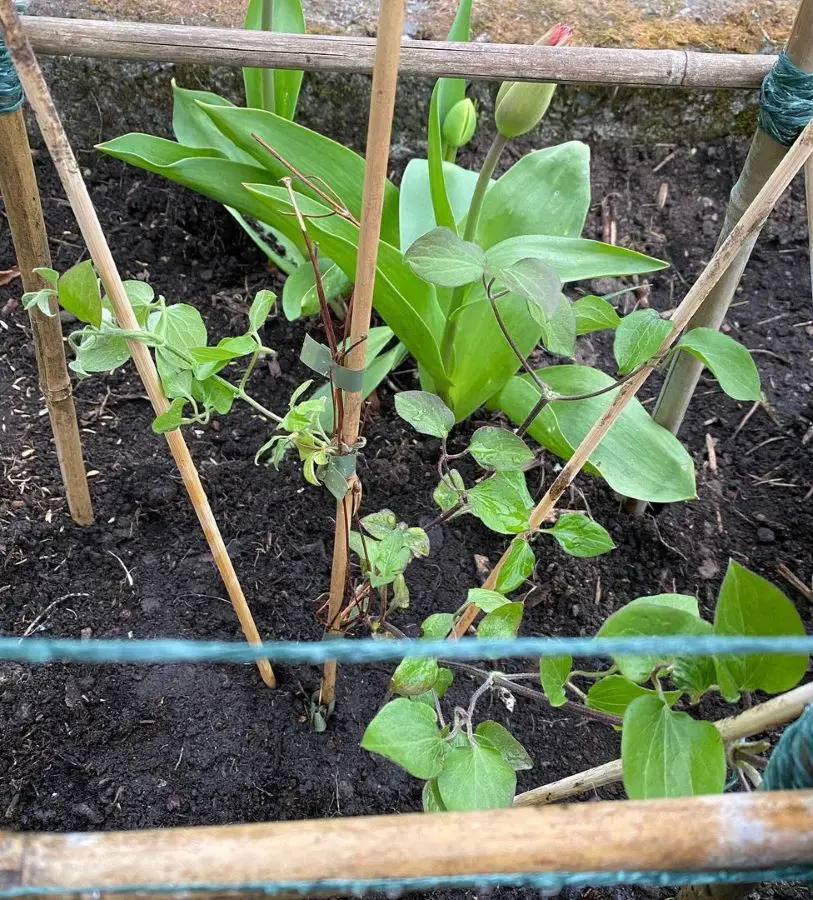
Clematis can be propagated from both seeds and vegetative methods such as stem cuttings or layering. But, the most common method of propagation is through vegetative means. Vegetative growing involves taking stem cuttings or layering stems from existing clematis plants to create new plants that are genetically identical to the parent plant.
This method ensures that the new plants will have the same desirable traits as the parent, such as flower color and form. The best time to propagate through stem cutting is typically late spring or early summer when the plant is actively growing and new growth is available for cutting. Here is how to do it:
- Choose a healthy clematis plant with strong growth.
- Pick a green, undamaged stem for cutting.
- Use clean pruning shears to take a 4-6 inch cutting.
- Cut below a leaf node on the stem.
- Optionally, apply rooting hormone to the cut end.
- Plant the cutting in a pot with well-draining soil.
- Cover the pot to create a humid environment.
- Put the pot in a bright spot with indirect sunlight, and keep the soil moist.
After several weeks, check for signs of root growth by gently tugging on the cutting. If you feel resistance, it indicates that roots have formed and the cutting has successfully rooted.
Once roots have developed, carefully transplant the rooted cutting into a larger pot or directly into the garden. Continue to care for the new plant as it establishes itself in its new location.
How To Harvest Clematis
If Clematis seeds or flowers are not harvested, they typically remain on the plant until they naturally disperse or decay. Harvesting typically refers to collecting seeds or flowers for various purposes.
- Seeds: Harvesting clematis seeds is done for propagation, especially if you want to grow new plants. Seeds are usually collected when the seed heads are dry and brown, typically in late summer or early fall. Allow the seed heads to dry on the plant, then gently remove them and collect the seeds. Store the seeds in a cool, dry place until you're ready to plant them.
- Flowers: While clematis flowers are not typically harvested for consumption, they can be cut for decorative purposes. Cut flowers for arrangements when they are fully open and at their peak bloom. Use sharp, clean pruners to cut the stems just above a leaf node. Avoid cutting more than one-third of the plant's stems to ensure continued blooming.
When harvesting clematis seeds or flowers, handle them gently to avoid damaging the plant. Additionally, always leave some flowers and seeds on the plant to ensure it continues to thrive and produce new blooms or seeds in the future.
Common Pests and Plant Disease
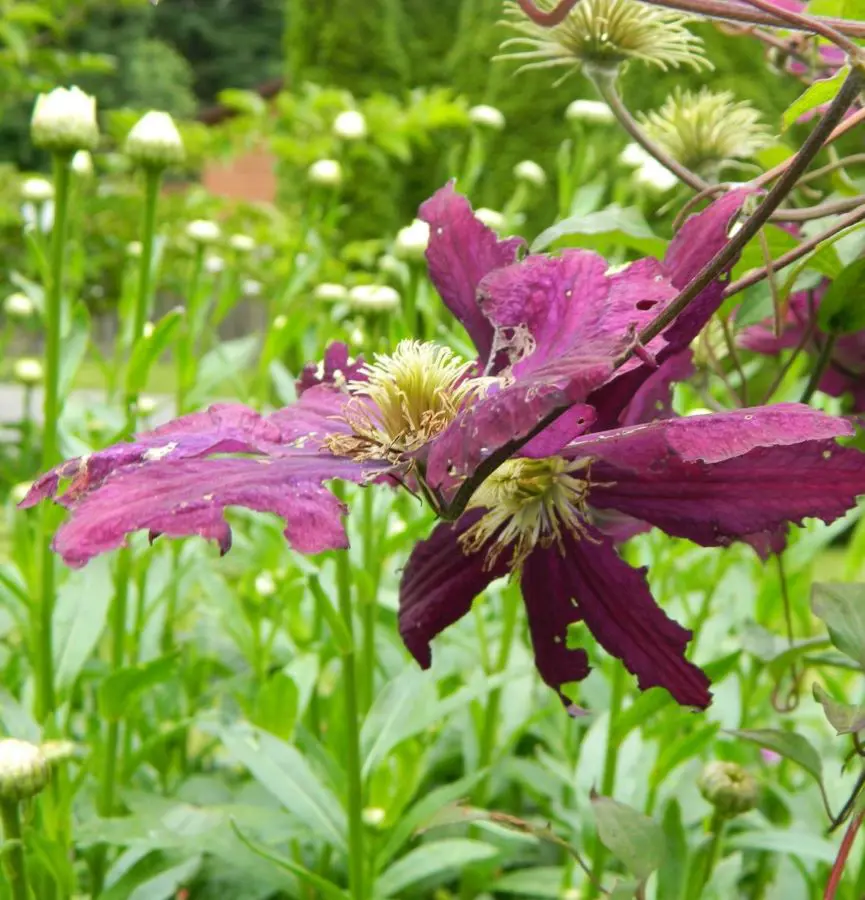
Clematis plants are attractive to pests and susceptible to diseases due to their lush foliage, succulent growth, and dense canopy, which provide ideal conditions for pest infestations and fungal infections. Additionally, environmental factors such as humidity, temperature fluctuations, and poor air circulation can exacerbate pest and disease problems in clematis plants.
Some common pests and plant diseases found in clematis include:
Pests
Pests like aphids, scale insects, and spider mites love clematis because they eat the plant's green parts, making the leaves look bad.
- Cause: While clematis attracts good bugs like bees, it also brings in bad pests because of its lush leaves and juicy sap, which bugs like to snack on.
- How to Treat To deal with bugs, you can use special oils or soaps, natural bug killers, or even helpful bugs like mites that eat the bad ones.
Diseases
Clematis can get sick from wilt, leaf spots, or powdery mildew, which can make the plant droop, change leaf color, or have fewer flowers.
- Causes: Things like fungal infections, bad airflow, too much or too little water, or not having the right place to grow can make clematis plants sick.
- How to Treat: If your clematis gets sick, cut off the bad parts, let air move around the plant better, take off sick leaves fast, water the roots without getting the leaves wet, and use special sprays to fight the diseases.
Additional Preventive Tips
- To keep bugs and diseases away, give your clematis the right care
- put it where it gets enough sun, use good soil that drains well, water it regularly, and add mulch.
- Also, prune it often to keep it healthy and remove sick bits.
- And if you need to use bug or disease sprays, choose ones that are safer for the environment.
Clematis Types
Clematis is a diverse genus with numerous varieties, offering a wide range of colors, shapes, and sizes. While there are many clematis varieties, some of the most popular ones include:
- Clematis 'Jackmanii': This is one of the most popular and widely grown clematis varieties in the USA. It features large, deep purple flowers that bloom prolifically from late spring to early fall.
- Clematis 'Nelly Moser': Known for its stunning bi-color flowers, 'Nelly Moser' produces large pale pink petals with bold magenta stripes. It blooms profusely in late spring and early summer.
- Clematis 'Henryi': This variety features large, pure white flowers with creamy-yellow stamens. 'Henryi' blooms from late spring to early summer and is prized for its elegant and classic appearance.
- Clematis 'The President': With its deep violet-blue flowers and contrasting yellow stamens, 'The President' is a striking and popular choice for gardens. It blooms from late spring to early fall, adding color and charm to the landscape.
- Clematis 'Ville de Lyon': This variety offers vibrant, rich red flowers that bloom profusely from late spring to early fall. 'Ville de Lyon' is prized for its intense color and long blooming period.
- Clematis 'Duchess of Edinburgh': Known for its double white flowers, 'Duchess of Edinburgh' produces an abundance of delicate blooms from late spring to early summer. It adds a touch of elegance and romance to garden trellises and arbors.
Challenges While Growing Clematis Plants
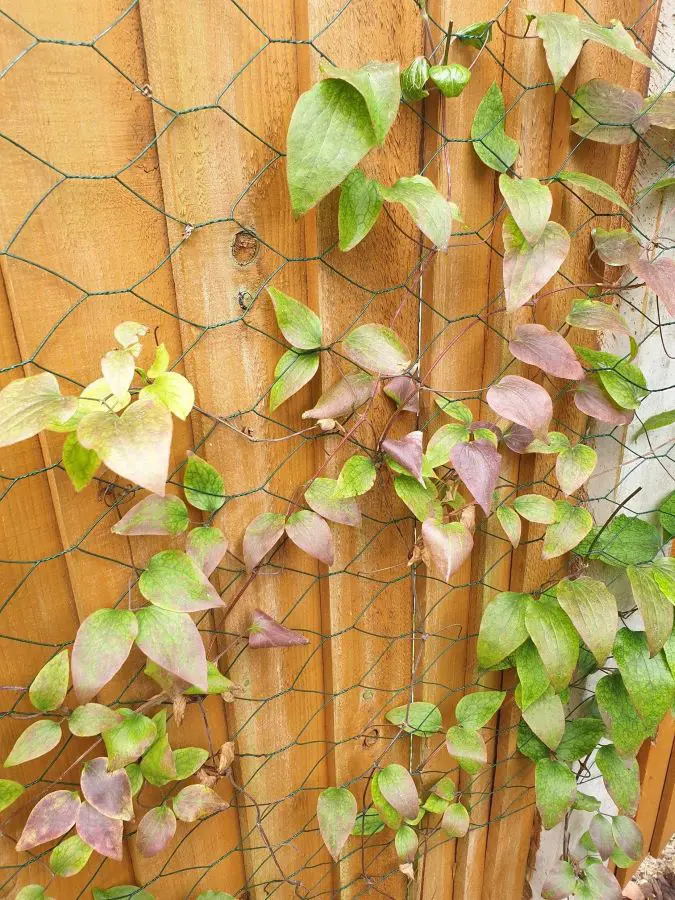
Growing clematis can be satisfying, but sometimes they can have problems that affect how well they grow. Here are some common issues and how to deal with them:
Wilting and Dying Shoots
If the soil gets too dry or too hot, the roots can get stressed out, making the shoots wilt and die. Too much water can also make the roots rot, which affects the shoots. To prevent,
- Make sure to water your clematis enough, but not too much.
- Keep the soil moist but not waterlogged.
- Also, protect the roots from too much heat and give them enough water to keep the shoots from wilting.
Stinky Ooze from Stems (Slime Flux)
When the stems start oozing a smelly goo, it's a sign of a bacterial disease called slime flux. This happens when bacteria get into the plant through damaged stems. This can be prevented by
- Cutting off the sick part of the stem right away using clean tools will save the plant.
- Also, shield your clematis from cold winds to stop stem damage and bacterial infections.
Grey Coating on Leaves (Powdery Mildew)
Powdery mildew is a common fungus that looks like grey or white stuff on leaves, stems, and flowers. It is like damp places with bad airflow, which makes the plant weak. To fix this
- Trim your clematis at the right time to improve airflow,
- don't wet the leaves when you water, and
- use special sprays to fight powdery mildew.
Other Problems
- Root Troubles: Diseases in the roots can make the leaves droop and hurt the roots. Make sure the soil drains well and don't overwater. If you see root rot, replant in fresh soil.
- Not Enough Nutrients: If your clematis isn't blooming, it might need more nutrients in the soil. Test the soil to see what's missing and add what's needed.
- Environment Issues: Make sure your clematis gets enough light, is planted at the right depth, and has good support to keep it healthy and happy.
Recent posts
Plant Care
Plant Care
How To Take Care Of An Orchid Plant? 11 Tips And Tricks
If you love gorgeous orchids but are worried they're too high-maintenance, don't worry. This guide is like a cheat sheet for orchid newbies. Forget fancy words and confusing schedules — we're talking about how to take care of an orchid pla...
Plant Care
How To Grow and Care For Peace Lily Plant
The Peace Lily is an indoor plant that is most valued for its beautiful and shiny green leaves as well as the white blooms. Hard and tolerant, it’s naturally a low-maintenance addition to your plant collection. If you are confused, let us tell ...
Plant Care
Pothos Plant Care And Growing Guide
Adding a Pothos plant (Devil’s Ivy) to your home benefits the environment and aesthetic of your personal space. It's easy to maintain and is loved for it's ability to enhance indoor air quality by removing toxins like formaldehyde, benzene, and...
Plant Care
Snake Plant Care and Growing Guide
Snake plants require low maintenance, and low light and are almost impossible to kill, making them a perfect plant for beginners and seasoned gardeners. In this guide, we will explore essential care tips and optimal growing conditions for snake plant...
Plant Care
How To Plant, Grow and Care Majesty Palm
The majestic palm, scientifically known as Ravenea rivularis, makes for a stunning indoor tree with its lush and grand fronds. Originating from Madagascar's river banks, this resilient houseplant is cherished not only for its beauty but also for its ...
Plant Care
How To Grow And Care For A Hosta Plant
Hosta plants are widespread perennials, often grown for their beautiful and diverse foliage. They are extremely easy to care for and can thrive in various conditions, particularly shade or semi-shade. These hardy plants can last for many years and re...
